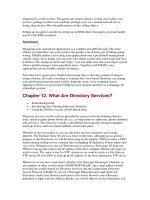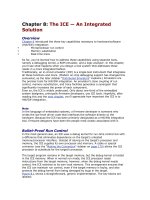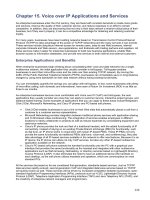isdn - integrated services
Bạn đang xem bản rút gọn của tài liệu. Xem và tải ngay bản đầy đủ của tài liệu tại đây (581.9 KB, 12 trang )
1
Ch. 5 - ISDN - Integrated Services
Digital Network
1 Overview
2 Basic elements in ISDN
3 ISDN - access
4 ISDN - the bus
5 ISDN - examples
6 ISDN - between LAN’s
7 ISDN - access to Internet
8 ISDN - small office solution
9 ISDN - large office solution
10 ISDN - bandwidth on demand
Ch. 5 - ISDN - Integrated Services Digital Network
2
Normally the user is connected to the network by analog lines. The signals are then digitized
and inside the network all communication is digital. ISDN brings the digital network to the
individual user.
Thus, the same twisted-pair copper telephone line that could traditionally carry only one
voice, or one computer or one fax "communication" can now carry as many as three separate
"connections" at the same time, through the same line. ISDN is the "magic" that makes this
happen.
The basic ISDN-to-user connection, called a BRI, which stands for Basic Rate Interface,
contains three separate channels. Two of these channels called the B channels, carry user
communication from a telephone, a computer, a fax or almost any other device. The third
channel called the D channel, carries call setup information for the network, but can also
carry user data transmissions, even if it is not normally used for this purpose.
That means that two separate "communications", say, a voice call and a computer
transmission, can take place at the same time through the same ISDN line. The power of
ISDN enables these two transmissions to happen at the same time, through the same copper
twisted-pair telephone line that once could handle only one transmission.
ISDN allows more information to be sent, more reliably and at higher speeds, and in most
cases without changing the telephone wiring in your house or building. Another advantage is
fast connection establishment. For example, with ISDN, it takes only few seconds to
establish connection with the Internet, compared to 40 seconds for an analog connection.
Ch. 5 - ISDN - Integrated Services Digital Network
3
There is a second type of ISDN called a PRI, which stands for Primary Rate Interface, that
is normally used by companies. PRI contains up to 32 separate channels. One of these
channels is D channel and the rest are B channels.
ISDN is standardized by ITU. There are different configurations of ISDN. The one used in
Europe is called Euro-ISDN.
There are different costs involved with ISDN. First you have a fixed fee for ISDN
subscription. Then you have an establishment cost each time you make a new connection
through the ISDN network. Finally you have to pay for the time you are connected.
ISDN is used for many different applications. One example is bandwidth on demand, which
means that ISDN is used as extra backup when the leased connection is overloaded.
Ch. 5 - ISDN - Integrated Services Digital Network
4
What components are needed to make ISDN work?
First you need an ISDN subscription from a service provider. Then you need a line box
called NT, which stands for Network Terminal equipment. In Europe this is installed by the
service provider, but in the USA it must be bought and installed by the user. You also need a
terminal adapter. This adapter is sometimes called an ISDN modem or an ISDN router.
Finally you need terminal equipment such as a PC or an ISDN telephone.
Ch. 5 - ISDN - Integrated Services Digital Network
5
Basic Rate Interface
The Basic Rate Interface, or BRI, is defined as two 64 kbps Bearer channels, and one 16
kbps Data channel. The D channel normally carries call setup data but could also carry user
data across the network. The BRI interface is also referred to as a 2B+D connection.
Primary Rate Interface
The Primary Rate Interface, or PRI, is defined as several 64 kbps B channels, and one 64
kbps D channel. The Primary Rate Interface has different configurations in different
countries. In the United States the PRI consists of 23B+D configuration. This amounts to a
total bandwidth of 1.5 Mbps, and is designed for transmission through a standard North
American T-1 trunk.
In Europe and the Pacific, the transmission standard differs from the one used in the USA.
The Primary Rate Interface is supplied through a standard 2 Mbps E-1 channel, and consists
of either 30B+D configuration used in Europe or 31B+D configuration used in the Pacific.
Although the specifics of ISDN implementation are still slightly different from nation to
nation, interconnections between any two systems in the world is now not only possible,
but increasingly practical.
Ch. 5 - ISDN - Integrated Services Digital Network
6
There are different kinds of cable buses used in ISDN.
In short bus configuration the maximum length between the NT and terminal equipment is
140 meters. The terminal equipment can be connected anywhere on the bus.
In extended bus configuration the maximum length between the NT and terminal equipment
is 500 meters. There are however some restrictions about where terminal equipment are
connected on the bus.
In both short bus configuration and extended bus configuration you can connect up to 8
terminal equipments, but the maximum length between two terminal equipments is 50
meters.
In Point-to-Point bus configuration only one terminal equipment can be connected to the
NT. The maximum length between the NT and terminal equipment is 750 meters.
Ch. 5 - ISDN - Integrated Services Digital Network
7
One application is WAN backup where you use ISDN together with a leased line. When the
leased line is overloaded or broken the ISDN connection becomes active.
Another application is remote access. This could refer to Internet access or access to a LAN
from a distant place.
A third application is Simultaneous voice, fax and data. This could be very convenient for
people working from home.
ISDN could also be used as a WAN service, connecting two LANs with each other.
Ch. 5 - ISDN - Integrated Services Digital Network
8
One popular application for ISDN is to connect LANs. The maximum bandwidth between
LANs is 128 kbps if BRI is used. If PRI is used the maximum bandwidth is 2 Mbps.
The ISDN call is automatically made by the router only when data is to be sent to the
network on the other side. The connection establishment time is very short and there are
practically no delays when the traffic flows. A timer configured by the owner of the router
can be set to disconnect the ISDN connection after some time.
Ch. 5 - ISDN - Integrated Services Digital Network
9
One of the major uses of ISDN is high-speed access to the Internet. More and more
applications on the Internet, like audio and video applications, demand higher bandwidth, for
satisfactory results. The normal 28.8 kbps is not enough any longer. One alternative, for
individuals and small companies, is to use ISDN.
In the picture you can see a normal configuration used by a small company. The equipment
is connected to ISDN through an ISDN router which has a BRI connection. In this case the
maximum bandwidth for Internet communication that a single user can have is 128 kbps.
Ch. 5 - ISDN - Integrated Services Digital Network
10
In the picture we can see two types of configurations. In the first type there is an ISDN
card installed in the PC, which can communicate directly with the NT. This is the cheapest
solution, but maximum two users can have ISDN access.
In the second type an ISDN router is used. In this configuration many users can have ISDN
access at the same time. A PC must have a network interface card to be able to communicate
with an ISDN router. This cards are not special in any way. Normal Ethernet cards for
instance have this functionality.
One common application for ISDN in these configurations is telecommuting. The idea is
simple: to "transport" as much as possible of the functionality of the office to a remote site
through a single ISDN BRI connection.
This functionality includes:
1. Acceptably high-speed access to the user's LAN and file servers.
2. Full access to mailboxes.
3. Access to the Internet.
Ch. 5 - ISDN - Integrated Services Digital Network
11
In the picture we see a large office using a PRI, ISDN connection. The advantage is that you
can use the bandwidth that you need for the moment. A PRI connection can use from 8 up
to 30 B channels. You cannot however use less than 8 B channels. A typical solution for PRI
is to connect some of the B channels to the PBX. The telephones which are connected to the
PBX can use the ISDN network to reach public telephone service. The other B channels
could be used for data communication.
Ch. 5 - ISDN - Integrated Services Digital Network
12
Frame Relay and ISDN are a common internetworking team, with Frame Relay handling the
main link and ISDN providing back-up capabilities, replacing traditional asynchronous
connections.
Leased lines have two major limitations. Peak periods of traffic that overload the available
bandwidth, causing congestion and delays. If the leased line is sized correctly, then a second
leased line of any capacity is overkill. In fact, normal, non-peak, traffic may be well below
the data rate of the existing line.
A second limitation is the lack of redundancy with a single leased line. For mission-critical
applications, as is frequently the case when leased lines are used, this can be a serious
limitation with devastating consequences.
Separate provisions that use dial-up lines can provide the necessary backup and overflow
bandwidth inexpensively and transparently. Unfortunately, integrating dial-up backup with
the existing leased lines can be a challenge. Most routers are not equipped to handle backup
and overflow cost-effectively.
A solution for this problem is an ISDN Basic Rate Interface service which provides dial-up
backup and bandwidth on demand.









